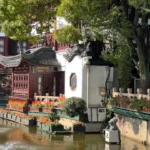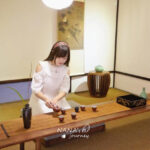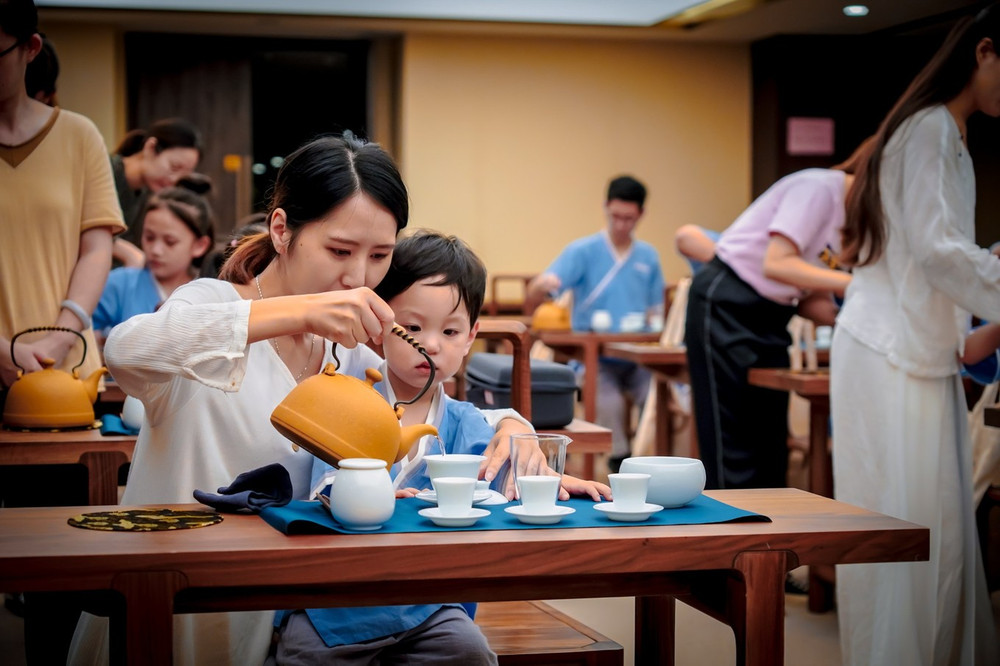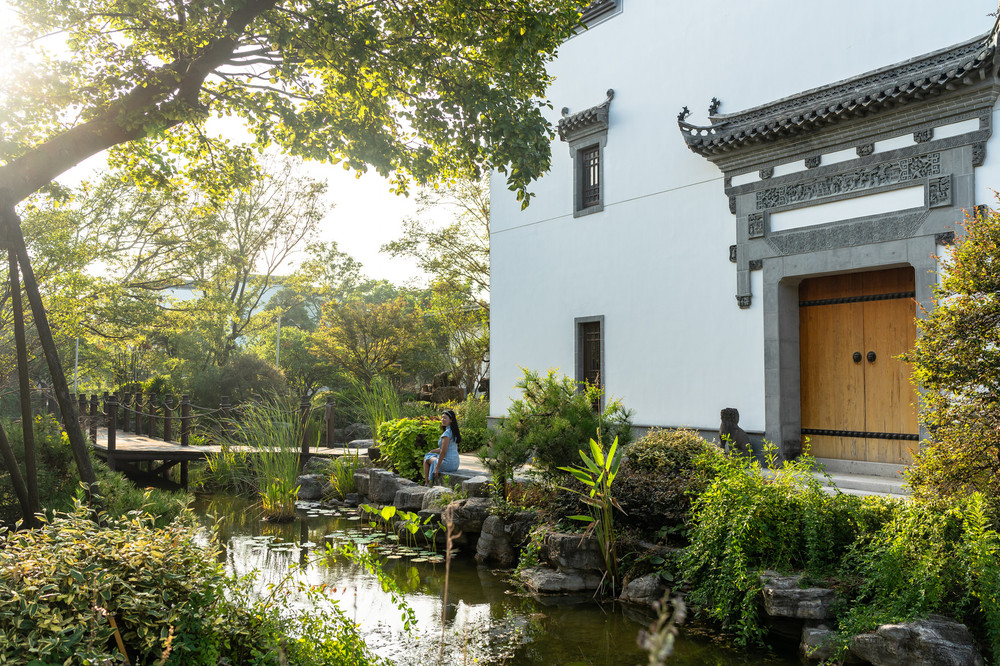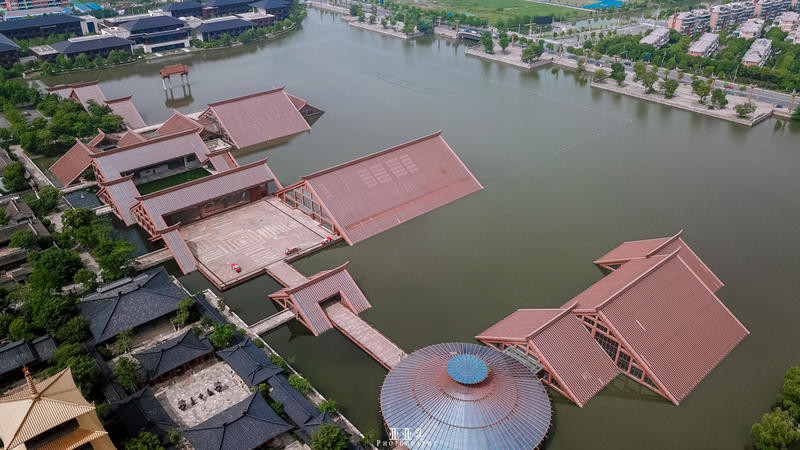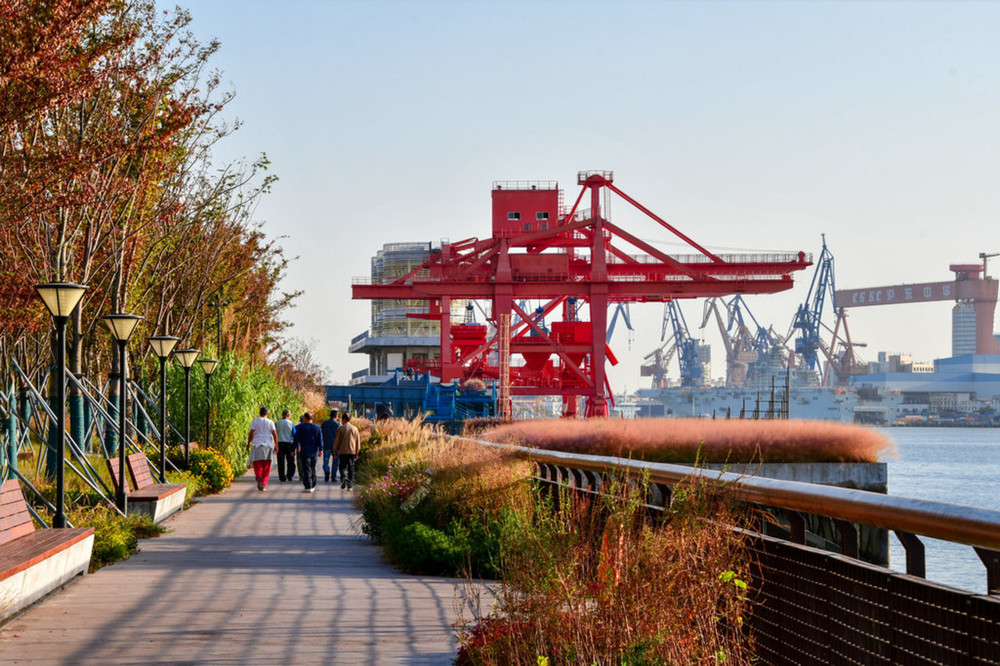**Trip to the Root of Shanghai: A Two-Day Exploration**
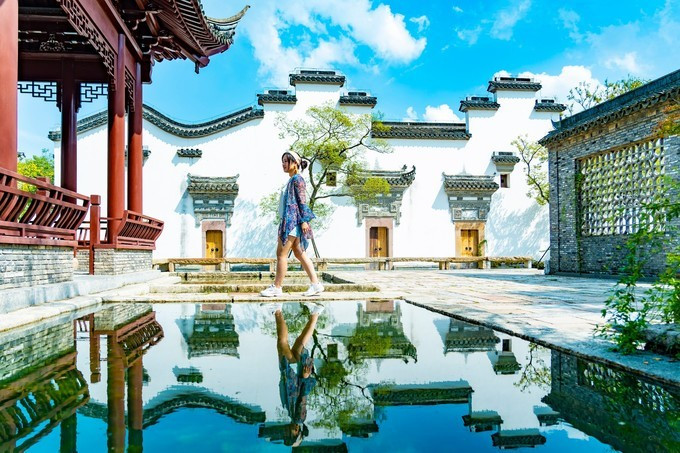
**Duration:** 2 days
**Time:** September
**Per Capita Cost:** 800 yuan
**Companions:** Friends
**Activities:** Photography, Cultural Exploration, Weekend Trip
*The author visited the following places:*
Guangfulin Site in Songjiang, Thames Town, Sijing Ancient Town, Shanghai Film Park, Fangta Garden, Zuibaichi, Zhongshu Ge, Fútián Jìng Temple, and Fangta.
*Posted on October 3, 2020, at 19:36.*
—
**Shanghai: A City of Constant Discovery**
Shanghai is truly enormous! Having visited many times, there are always new discoveries and gains. This city gives me the feeling that the pace of life is too fast. Traffic jams occur easily, and even subways and buses are crowded. But this is also its charm as an international metropolis. The urban area has been visited many times. So this time, I want to deeply understand the origin of Shanghai through its glamorous surface and thus turn my attention to Songjiang District.
**Why Songjiang?**
Archaeological discoveries at the Guangfulin Site in Songjiang unearthed Shanghai’s architectural complex from 4,000 years ago and for the first time excavated five tombs with human bones. A large number of cultural relics from the Neolithic Age, Zhou, Han, Song, Yuan, and other periods were unearthed, providing rich and detailed physical materials for restoring the ancient history of Songjiang District and even Shanghai. Therefore, Songjiang District is known as the ‘root of Shanghai’, which is the origin of this city.
**Songjiang: A Modern and Fashionable Root**
This two-day trip to Songjiang, Shanghai included eight scenic spots including the Guangfulin Cultural Site Park. The others are: Yunjian Granary, Thames Town, Sijing Ancient Town, Shanghai Film Park, Laiyifen Snack Museum, Fangta Garden, and Zuibaichi Scenic Area. My overall impression is that as the ‘root of Shanghai’, Songjiang’s scenic spots are not at all old-fashioned. They are extremely modern and fashionable, full of ‘internet celebrity’ attributes and very in line with the temperament of Shanghai. If you don’t believe it, come and take a look with me!
**Guangfulin Cultural Site Park**
Guangfulin was originally called Huangfulin and Guangfulin. In ancient times, it belonged to the Huating Valley category and gave birth to the splendid ancient Guangfulin culture. It was the cultural, political, economic, and transportation center in the eastern part of Soochow in ancient times… Until Huating County was established in the Tang Dynasty. The Ming and Qing dynasties created the glory of Songjiang and have profound cultural connotations.
Although not all the buildings in the current ruins park are left over from history, the comprehensive venues are a good place to understand the history and culture of Songjiang and even Shanghai. In my opinion, the modern buildings in the Guangfulin Cultural Site are very in line with design aesthetics and are very interesting in themselves. In the visiting venues in the park, I also gained a lot of historical knowledge eagerly.
For example, as early as the late Neolithic Age four or five thousand years ago, rice was already widely planted locally. The long history of farming shows that the local area had an advanced agricultural production method and so on. Among them, the Guangfulin Archaeological Site Exhibition Hall is definitely one of the must-visit venues. Its main body is composed of three independent exhibition halls and a main hall. There are 159 groups of cultural relics on display. Among them, three bronze zuns are the first bronze ritual vessels unearthed in Guangfulin. As the earliest ritual learning of Zhou etiquette culture, bronze wares also reflect from the side that Guangfulin at that time was already a developed society, which is of great significance.
**Yunjian Granary**
Songjiang also has a very pleasant alternative name called ‘Yunjian’. After the founding of the People’s Republic of China, a large granary was built next to Fangta Garden in the south of the old city of Songjiang and was named ‘Yunjian Granary’. However, with the rapid development of Shanghai, the storage function of Yunjian Granary as grain has been abandoned. However, the granary has been preserved and developed into a cultural industrial park.
There are numerous examples in China of abandoned factories eventually becoming popular internet check-in spots, such as Chongqing’s Goose Ridge Factory II, which became famous due to a movie, and Chengdu’s Eastern Suburb Memory, among others. Thus, my expectations for Yunjian Granary were quite high before my visit.
As early as the Ming Dynasty, Songjiang was a primary source and storage location for grain tribute to the feudal court and one of theThe peeling walls and rusty old equipment now stand as witnesses to the rapid development of Songjiang. The new landmark of Yunjian Granary is a series of artistic graffiti, art venues, and popular bars developed by the park, making it an excellent place for tourism, leisure, and experiencing culture and art. I particularly enjoy the graffiti on the walls and have photographed almost every piece with my camera.
Upon entering Thames Town, one immediately notices that it is a popular internet check-in spot. The town, from its overall layout to every brick and tile, reflects the authentic European style. The bright architectural appearance, combined with the beautiful weather of blue skies and white clouds, makes for a perfect encounter. Thames Town is a large community with multiple functions, including living, tourism, and leisure. However, each neighborhood presents its own unique characteristics, and there are over 400 acres of lake views and beautiful yacht marinas, truly achieving a change of scenery with every step (whispering quietly: I’m really envious of those who can live here). Thames Town has over 200,000 square meters dedicated to public amenities and commercial services, including a fitness club, art gallery, and the Thames Catholic Church. The chain bookstore ‘Zhongshuge’ is the place I most want to recommend to everyone. As the first generation of ‘internet-famous bookstores,’ Zhongshuge is even considered a benchmark for the transformation of physical bookstores in China and has given a new perspective on the transformation of the gradually declining paper book industry. If you are a literary youth who loves paper books, you cannot not know Zhongshuge, as not only can you buy books here, but it is also too beautiful for photography. The literary atmosphere of Thames Town goes far beyond this; even the transportation to get here is different, with the entire yellow tram, which is very eye-catching as it穿梭 through the streets, making it feel as if you are really stepping onto the European continent.
Sijintown, with its profound historical heritage in Shanghai, is home to many well-known ancient towns. However, the Sijintown located in the northeastern part of Songjiang District is not very well-known. In fact, it is also an ancient town with a history of over a thousand years, even having the saying ‘A hundred years of Shanghai, a thousand years of Sijin.’ So during this trip to Songjiang, I made a special visit to see it. The first thing that caught my eye was the ancient archway below, which appeared very grand, and the details took me a long time to ponder over. It is said that within the ancient town’s scenic area, there are 53 historical buildings, giving birth to a large number of historical and cultural celebrities such as the famous historian Tao Zongyi, the Ming Dynasty calligrapher and painter Fan Yulin, the founder of Fudan University Ma Xiangbo, and the founder of ‘Shenbao’ Shi Liangcai. There are also some visitable venues within the ancient town where you can learn about the history and culture of Songjiang and Shanghai. There is also a Futian Jing Temple in the ancient town, whose predecessor was the Dongtian Temple that still existed in the early days of the founding of the People’s Republic of China, which also has a history of a thousand years. According to historical records in ‘Water Town Ancient Town Talks about Si Jing’, the formation of Si Jing Town originated from temple fairs. During the reign of Emperor Zhenzong of the Song Dynasty, from Xianping to Xiangfu years, Dong Tian Temple and the pagoda were already constructed, becoming a sacred place for believers. Temples were one of the most important social venues in ancient times when spiritual life was relatively scarce, making this ancient temple a witness to the history of Songjiang.
When it comes to film cities in the Jiangsu and Zhejiang regions, most tourists think of Hengdian. However, I prefer the ‘small but refined’ Shanghai Film and Television Park, as it is located in Shanghai and showcases ‘Old Shanghai’. Established in 1992, the park features street scenes such as Nanjing Road and Shikumen lane groups, which are imitations of old Shanghai architectural complexes from the Republic of China period, allowing visitors to travel back to the 1930s in an instant… Shanghai in the last century was already deeply influenced by Western architecture, hence the park also includes European-style architectural complexes such as the Moller Villa, churches, German-style villas, Spanish buildings, and English villas, which are so beautiful that many wedding photography studios come to capture scenes. Among them, the Moller Villa located at the north end of the park is an antique architectural complex with a Norwegian cultural background, originally situated on Shaanxi South Road in Shanghai. It is said that there is a warm little story behind its origin, which is why the Moller Villa is also known as the Dream Apartment and is now one of the landmark buildings inOf course, when visiting the park, it is particularly important to note that you might accidentally encounter celebrities while walking around, as many films and TV dramas have been filmed here, such as ‘Endless Love’, ‘Sparrow’, and ‘Kung Fu’. So, keep an eye out for familiar scenes.
By the way, during this visit to the park, I discovered that during the National Day period (from the 1st to the 8th), the park will host the ‘Splendid China? Great Beauty of Qipao 2020 Shanghai Qipao Culture Art Festival’, which is both fun and pleasing to the eye! The Qipao is also one of the essential elements of ‘Old Shanghai’. When I mention these two words, I am reminded of Maggie Cheung wearing various Qipao in the movie ‘In the Mood for Love’, which is truly full of charm!
Young people love snacks, but fewer and fewer people are willing to spend time in supermarkets. With the internet being so advanced, it is much more convenient to order snacks online with just a click of a finger or to visit snack stores for one-stop shopping. This has also led to the rise of many popular online fast-selling snack brands, ‘Laiyifen’ being one of them. However, this time in Songjiang, instead of visiting a Laiyifen store, I went to the Laiyifen Snack Museum to understand how the snacks we consume daily are produced, selected, and about the culture of snacks. It is not an exaggeration to say that the museum displays snack culture. The museum has several themed areas such as the Snack Gathering, Snack Street, and Cultural Corridor, with bold and lively colors and illustrations, creating a high-value interesting space loved by tourists of all ages. Of course, the snack museum is not just for watching the excitement but also a good place to learn, exploring the story of the delicious craftsmanship given by nature in the educational snack culture atmosphere. There is also a high-value coffee book bar on the second floor, where you can sit down, take photos, and check in if you are tired while shopping. You can also learn about coffee and tea culture.
Why establish a snack museum when selling snacks? According to museum staff, this venue is a significant exploration by Laiyifen to help China and the world deeply understand Chinese culinary culture amidst the backdrop of consumer upgrade and internationalization of the food industry. It encompasses three major themes: historical heritage, innovative development, and shared experiences. In essence, as food enthusiasts increase, Laiyifen has chosen to establish a museum to showcase this new experience shifting from basic needs to refined demands, aiming to eat with culture, spirit, mission, and taste.
Fangta Garden is a garden in Songjiang themed around viewing historical artifacts. Before visiting, I thought it would be a relatively niche attraction, but I was surprised to find quite a few local tourists. I believe this is mainly due to the rich history of Fangta Garden and its very affordable ticket price. A 12 yuan ticket might not even buy a cup of milk tea in downtown Shanghai, but it allows you to experience a thousand years of culture at Fangta Garden. The garden covers an area of about 182 acres. Originally the bustling city center of ancient Huatian during the Tang and Song dynasties, it is bordered by Amin Street to the east and Sanguang Street to the west. It was a gathering place for ancient literati and a microcosm of Songjiang’s historical sites. In other words, this place was the city center in ancient times and has now become a niche tourist destination. The garden’s screen wall is one of the oldest, most exquisite, and best-preserved large brick carving art treasures in Shanghai and even the country. It measures 4.75 meters in height and 6.1 meters in width and is a large brick relief carving. The Fangta is the garden’s iconic structure, a brick-wood structure with nine levels and a square shape, originally built in the late Song Dynasty and renovated multiple times, standing at 42.5 meters high. It is like a graceful Jiangnan woman, with the wooden ladder inside the tower being narrow and steep, becoming increasingly smaller as you ascend, and it is no longer possible to climb beyond the seventh level. The door hole on the seventh level is less than a meter high, requiring one to crawl to get out. Therefore, Fangta is also known as the ‘most delicate’ tower in the southeast. The ancient poem ‘Sixty-three floating towers near the sea, how can they compare to the exquisite Fangta’ best interprets it.
Zui Bai Chi Zui Bai Chi Park is quite similar to Fangta Garden, both being typical Jiangnan classical gardens with a ticket price of 12 yuan per person. The garden has a history of over nine hundred years since its inception. Named Zui Bai Chi, it has also experienced more than three hundred years and stillThe garden layout centers around a pool of water. On three sides surrounding the pool are winding corridors and pavilions. Personally, I felt it was a 360-degree view without any dead angles. No matter where you stand, the scenery is excellent. As long as you are not stingy with your shutter, you are sure to take many good photos. There are no lack of ancient ginkgo and camphor trees with an age of three to four hundred years, which are unmatched by newly built gardens. In fact, Zui Bai Chi has a significant history and is known as one of the five major classical gardens in Shanghai, along with Yu Garden, Jiading Ancient Yi Garden, Qiuxia Garden, and Qingpu Qu Shui Garden. It is the oldest among the five gardens. Perhaps it is a microcosm of Songjiang tourism, with considerable resources but not as many tourists as in the city center. Whether it’s to experience historical culture or to take trendy photos, the experience is excellent! Based on the announcements of various scenic spots, I have organized the recent activity announcements for various scenic spots in Songjiang for everyone. I recommend collecting them!


